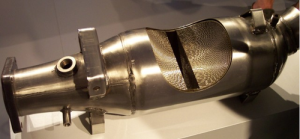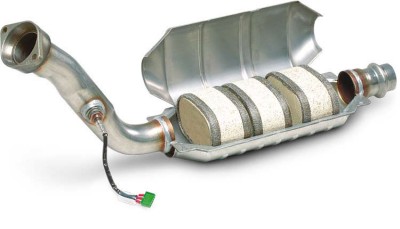The catalytic converter is one of the essential components of the vehicle emission control system. It treats many of the harmful emissions produced by the engine, converting them into water and harmless gases. If the catalytic converter malfunctions, it must be replaced quickly.
 The catalytic converter is a sophisticated engine component that utilizes various principles of organic chemistry. The core is usually a ceramic monolith with a honeycomb structure. A film of precious metal is laid over the monolith, which serves to intercept the exhaust gases and decompose them. This reaction, occurring at high temperatures, causes the exhaust to be much less environmentally harmful. The ceramic monolith is enclosed within a sealed casing and is further protected by a coating of insulation.
The catalytic converter is a sophisticated engine component that utilizes various principles of organic chemistry. The core is usually a ceramic monolith with a honeycomb structure. A film of precious metal is laid over the monolith, which serves to intercept the exhaust gases and decompose them. This reaction, occurring at high temperatures, causes the exhaust to be much less environmentally harmful. The ceramic monolith is enclosed within a sealed casing and is further protected by a coating of insulation.
A poorly maintained or faulty catalytic converter results in excessive fuel consumption as well as a loss of engine power and overall performance.
In theory, a catalytic converter is designed to last the lifetime of the vehicle, or so manufacturers claim. It is now common knowledge, however, that catalytic converters on average last approximately 120,000 km.
The catalytic converter is only effective at temperatures above 750°F. That is to say, it takes a few minutes (roughly 10 km) before the catalytic converter really begins to do its job. Therefore, it is within these first few kilometers of driving that toxic gas emissions are the most significant.
On short trips, since the engine doesn’t have sufficient time to warm up, the catalytic converter becomes dirty. And in this day and age, half of all trips made by motorists are short ones.
In fact, city traffic represents half of all kilometers traveled by motorists in France. That’s 398 billion kilometers of short trips driven per year.
In effect, these are the types of modern driving conditions which lead to the premature aging and overall decreased performance of catalytic converters.



